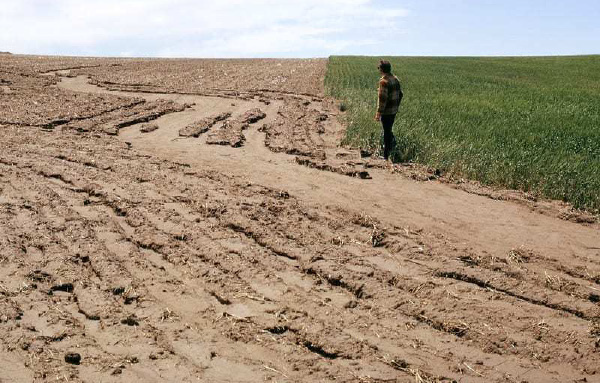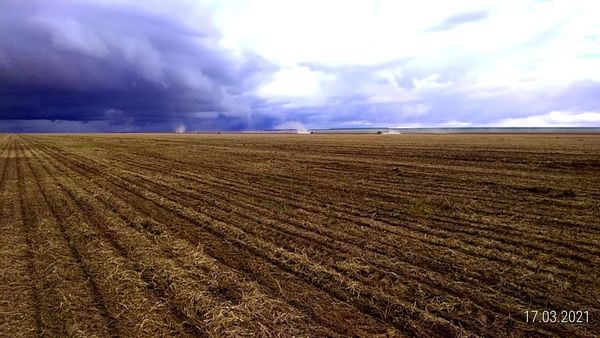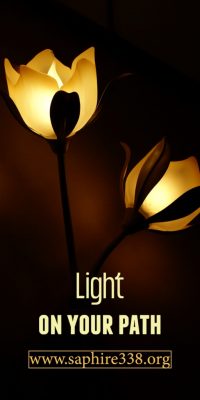
GRAIN is a small international non-profit organisation that works to…
Read Next

Farmer looking at erosion in field. Photo: populationeducation.org
- The world’s largest agrochemical companies want to use carbon credit programmes as a smokescreen for the emissions of big oil, food and tech corporations.
- Faulty carbon sequestration schemes reinforce a model of industrial agriculture and food that erodes soils and is responsible for over a third of global greenhouse gas emissions.
- Farmer organisations and civil society groups in several countries are struggling to stop governments from passing legislation that would make these corporate carbon farming schemes core parts of national emission reduction plans.
- Only through a vast programme of agroecology, land redistribution and the re-localisation of food systems can we effectively build carbon back into the soils and cut emissions in the food system.
Industrial agriculture is much like a sprawling mine. To get big yields, lands are mined of nutrients and then increasing amounts of chemical fertilisers are added to make up for the loss. The chemical fertilisers themselves are produced by mining minerals and extracting fossil fuels elsewhere.
There are ways to farm without depleting soils, but, over the years, agribusiness corporations and governments have sidelined such alternatives. Small farmers with the knowledge, practices and seeds to maintain healthy soils have been pushed off of their lands and criminalised. Researchers exploring ways to reduce fertilisers by building up plant root systems or soil biodiversity have been marginalised, underfunded and shut down. Meanwhile, millions of hectares of fertile forests, savannahs and peasant farmlands and pastures have been cleared to make way for sterile plantations growing only a few chemically-dependent varieties of commodity crops.
The result is a catastrophic loss of soil organic matter– the building block of healthy soils. Over half of the soil organic matter in the world’s agricultural soils has already been lost, with over 2 billion hectares of farmland badly affected.[1]It translates into declining crop yields, increasing pollution of water systems from fertiliser run-off, and because soil organic matter is mainly composed of carbon, the release of enormous amounts of carbon into the atmosphere.
Yet, the main culprits behind this soil catastrophe are now recasting themselves as soil saviours. The world’s top fertiliser company, Yara, recently created an alliance to pursue “a new solution to our carbon challenge that’s grounded in the soil”. Global commodity trader Cargill is rolling out several new initiatives to support what it calls “regenerative agriculture”. “Soil health is a win-win,” says Cargill. Over the past couple of years, nearly all of the biggest corporate players in agribusiness have launched or joined initiatives to restore carbon in agricultural soils (see Table 1).
The reason is simple; there is now money to be made from storing carbon in the ground. Governments and corporations are desperate to find ways to avoid making real cuts to their fossil fuel emissions and are willing to pay others to sequester carbon so they can continue burning fossil fuels. The challenge is to find places to sequester this carbon– and what better place than in the world’s carbon-depleted farmlands? Some estimate the capacity to sequester up to 3.4 Gt of carbon per year in agricultural lands– which is roughly one-third of the annual emissions from the fossil fuel and cement sectors.[2] With a price of about USD$20 per tonne of carbon sequestered on today’s carbon credit markets, that’s a lot of money that’s potentially out there to be made. Enough to attract the most notorious soil miners.
If this “win-win” sounds too good to be true, that’s because it is. Yes, as La Via Campesina and many other organisations have long argued, we need to build carbon back into the soils to address the climate crisis.[3]But this requires a vast programme of agroecology, land redistribution and the re-localisation of food systems. And it certainly cannot be done at the cost of enabling more fossil fuel emissions. The carbon farming programmes that corporations are hastily pushing are fraught with problems. They amount to a big soil grab. These programmes are designed to greenwash pollution and consolidate control over food and agriculture in the hands of a small number of corporations, whose activities are increasingly integrated through digital platforms.
The ABCs of carbon credit farming
The typical soil carbon farming programme looks like this.
Farmers sign up for the programme online. They then have to start implementing certain farming practices that are supposed to draw carbon into their soils. These are generally limited to planting cover crops and doing less or no-tillage but can also include integrating trees or applying fertilisers more efficiently.
Farmers log their practices onto corporate digital platforms, but satellite or aeroplane surveillance monitor their farms. Some programmes require farmers to submit soil samples; others rely entirely on remote verification systems. Farmers generally have to maintain these practices and are responsible for keeping the carbon sequestered in their soils for between 5-10 years to fulfil their contract. However, timelines can extend to 20 or 25 years.
Farmers are then paid based on the calculated amount of carbon sequestered and the prevailing price for carbon in global carbon credit markets. Typically 20-25% is deducted to account for future losses of carbon that could occur after the programme ends or because of calamities like droughts and fires. The company typically takes another 25% as fees.
There are a growing number of these carbon credit farming programmes out there, most of them led by or connected to a multinational agribusiness corporation. Nearly all of them are based in areas where agriculture is dominated by large-scale farms producing a few commodity crops, such as the US, Brazil, Australia and France. They focus almost entirely on the adoption of two simple practices: rotations with cover crops and reduced or no-tillage (no-till), which essentially involves burning down weeds with a broad-spectrum herbicide like glyphosate.
There are a few exceptions. Yara is testing a pilot programme in India through its Agora Carbon Alliance, and the Dutch agribusiness lender Rabobank has a partnership with Microsoft that pays small farmers in Asia, Africa and Latin America to plant trees on their lands. Rabobank intends to sign contracts with 15 million farmers within the next decade.[4]
Magical thinking
Corporations are pushing ahead with these carbon credit programmes even though there are many well-known problems and limitations.[5]
The most glaring problem is that these programmes are all based on offsets. The companies finance their programmes by selling credits to corporations or governments to offset their actual fossil fuel emissions. But it isn’t possible for soils to absorb enough carbon to significantly offset global fossil fuel emissions. In a best-case scenario, soils could absorb roughly the amount of carbon that has been historically lost from industrial agriculture, after which there can be no further sequestration. Soil carbon sequestration can in no way substitute for immediate and deep reductions in fossil fuel emissions.[6]Moreover, since soils are one of the only major carbon sinks that exist, we should only use them to allow for the most critical sources of emissions needed for our survival, not to offset the emissions of corporations like Walt Disney and PepsiCo.
Another major problem with these corporate programmes is the lack of permanence. While cuts to fossil fuel emissions are real and immediate, there is no guarantee that the carbon sequestered by carbon credit farming will not be released back into the atmosphere. Most carbon credit farming programmes last ten years when carbon needs to be stored for at least 100 years to meaningfully make a difference to global warming. Once the programme ends, land can be converted to a parking lot or ploughed up and doused with chemical fertilisers without any penalty. Indeed, climate change will lead to more weather events, like droughts and fires, that greatly increase the risks of carbon being released from the soil. To make up for this lack of permanence, carbon credit farming programmes usually deduct 20-25% from the credits accredited to participating farmers as a buffer– but there is no scientific basis to this figure. Indeed, one US carbon farming company admits it would cost over ten times more for credits that are based on 100 years of carbon retention in the soils.[7]No carbon credit buyer is willing to pay this much.[8]
Then there is the issue of how to measure the carbon sequestered. Annual soil testing and field visits are expensive and, in practice, prohibitive without subsidies or a much higher carbon price. The OECD estimates that these costs, combined with financial fees, can add up to 85% of the total value of the carbon credits.[9]The EU’s LifeCarbonFarming scheme estimates costs to each farm for validation, verification, and market registration of €110,000-240,000 (USD 124,483-271,600) over the first five years![10]In some cases, the farmer has to pay for these costs; in most cases the costs are integrated into the programme. But, either way, the high costs mean that rigorous verification is completely out of the question when it comes to small farms and barely economical for even the largest farms.
To bring costs down, corporations are focussing their efforts on developing remote verification systems, where satellite and aeroplane monitoring, historical soil records, and models are used to estimate the carbon sequestered.[11]Remote verification, however, can never be as accurate as soil testing. For example, researchers looking into carbon credits purchased by Microsoft from a large-scale pasture farm in Australia where remote verification was used found that the level of carbon sequestration was greatly overestimated.[12]Moreover, remote verification becomes even less accurate when farmers are not growing large-scale monoculture crops using uniform industrial practices. It cannot effectively measure soil carbon changes in complex, agroecological farming systems, where multiple crops, livestock and trees are integrated. In fact, even soil testing has its limitations. A recent global survey found that farming without tillage (no-till) only increases the soil organic matter at the surface level of the soil, where soil test samples are taken, but when samples are collected that cover a greater depth, there is no significant change in carbon.[13]
An additional problem with corporate carbon farming is the issue of “additionality”. To qualify as carbon offsets, farmers enrolled in carbon farming programmes have to show that they are sequestering carbon that would not otherwise be sequestered. Suppose a programme is launched in an area where farmers had already started planting cover crops for other reasons (for example, restoring soil health). In that case, it will not be possible to determine how much “additional” planting of cover crops is due to the programme. This is particularly true for the corporate programmes since they rely almost exclusively on farms adopting practices, like cover crops and reduced tillage. However, many farmers were already adopting them without the carbon schemes and are likely to adopt these practices as other incentives come into being, like public programmes or new markets for cover crops.[14] In Brazil, for instance, the government claims to have already converted 8 million hectares to no-till through an emissions reduction plan that provides low-interest loans to participating farmers– without the need for carbon credits.[15]
And then, there is the issue of the greenhouse gases these carbon credit farming programmes generate. Nearly all the programmes focus narrowly on quantifying carbon sequestered in the soil and do not consider the overall emissions that industrial farming produces. They do not factor in the amount of chemical inputs a farm applies or the amount of fossil fuels burnt running tractors and other machinery, or the increased emissions that can result from the first years of transition to no-till.[16]They do not account for the emissions produced by their remote verification systems either– from the energy needed to store the data these systems generate to the aeroplanes or satellites they use to monitor farms. And they are based on tweaks to a model of industrial agriculture that depends heavily on chemical inputs and that supplies a hugely wasteful and polluting corporate food system.[17]
Given all of these problems, there is simply no way that the carbon that these programmes claim to sequester in the soil can be equated with concrete, reductions in greenhouse gas emissions. And yet agribusiness corporations continue to steamroll ahead with more projects, while climate polluters like Shell and Nestlé eagerly buy up the credits– and the EU, the US, Brazil and other governments look to emulate Australia and make these programmes part of their national climate plans (see Box on Australia).

Insolo’s soybean farm in Piaui, Brazil. Photo: Insolo
A global soil grab
The corporate interest in carbon farming extends beyond simply greenwashing industrial agriculture or offsetting emissions. It provides a powerful incentive to draw farmers into the digital platforms that agribusiness corporations and big tech companies are jointly developing to influence farmers on their choice of inputs and farming practices.[18]Most corporate carbon farming programmes already require farmers to sign-up to the apps of agribusiness companies, and programmes that operate independently are rapidly being bought up. Moreover, these platforms, as well as the remote verification systems, are often based on partnerships with big tech companies, like Microsoft and IBM, who are themselves major buyers of carbon credits.[19] The companies intend to make their digital platforms one-stop shops for carbon credits, seeds, pesticides and fertilisers and agronomic advice, all supplied by the company, which gets the added benefit of control over the data harvested from the participating farms.
Farmers, on the other hand, have little to gain. The carbon sequestered payments per tonne do not justify the added costs unless you farm on thousands of hectares.[20]At the farm level, those best placed to benefit from these programmes are the pension funds and billionaires who have been buying up large farmland areas in recent years.[21]It provides them with an additional potential revenue stream and can be factored into the asset value of their lands. It can also be added to their portfolio of “green” investments. Financial managers can now use digital platforms to buy farms in Brazil, sign them up for carbon credits, and run their operations all from their offices on Wall Street.[22]
Well-grounded solutions
The food system is the source of over a third of global greenhouse gas emissions, and climate actions must focus first and foremost on reducing emissions, not offsets. Programmes that help farmers to restore carbon in their soils are necessary and should be publicly supported. Still, to effectively deal with the climate crisis, they must be firmly integrated with larger actions to eliminate greenhouse gas emissions on the farm and throughout the food system. This requires a rapid phase-out of nitrogen fertilisers and other chemical inputs. It means a widespread shift to agroecological farming, along with support to local food markets that can bring these foods to nearby consumers and actions that ensure small farmers have access to lands and water. It means a revitalisation of farmer seed systems focussed on developing varieties adapted to local contexts and not dependent on chemical inputs. It involves policies to eliminate the surplus production and consumption of high-emissions foods, like meat and dairy, and the wasteful and unhealthy ultra-processed foods that the big food corporations heavily promote.
The food and agribusiness corporations that profit off of today’s global food system will not support these real solutions. Corporations are cogs in the wheel, and unless their power is challenged, they will continue to block necessary action and push us into diversions like carbon credit farming. No amount of greenwashing can alter that reality.
Australia’s soil grab and similar threats in other countries
Australia established a national Carbon Farming Initiative in 2011 to generate offsets to meet its emissions reduction targets. Projects that meet the Initiative’s guidelines can sell Australian carbon credit units (ACCUs) through the Climate Solutions Fund to the government or Australian corporations. So far, the government has been by far the largest buyer of ACCUs.[23]Some of the corporations participating in these projects include Shell, through its subsidiary Select Carbon, and TotalEnergies, through a tie-up with the Australian carbon farming company Agriprove.
The Initiative has had difficulty generating enough carbon credits to meet the demand from Australia’s big emitters, who much prefer offsetting emissions to reducing them. So, to increase supply, the government has opted to lower standards for carbon credits, such as dropping the obligation on carbon farming projects to ensure a permanence period from 100 years to 25 years. However, with the price for carbon credits increasing, Australia is now faced with a carbon credit land grab. In early 2022, the government put forward legislation to give it a veto on carbon farming projects of over 15 hectares to stop financial companies from buying up farmland and converting it to tree plantations for carbon credits. The government needed the veto because investors were buying up large swaths of productive agricultural land only to “simply walk away and throw away the key”.[24]
Others warn that Australia’s purchase of millions of carbon credits from carbon offset projects that cannot guarantee permanence will jeopardise its overall emissions targets. The vice-chair of the Intergovernmental Panel on Climate Change, Mark Howden, says Australia’s reliance on soil carbon to cut emissions is “problematic and risky” as the climate warms. “As things get hotter and drier, which is the prediction for southern Australia, then the soil carbon is likely to go down,” he says.[25]
Yet other governments with highly polluting agricultural sectors seem determined to follow Australia’s questionable path. The National Family Farm Coalition and other civil society organisations in the US are locked in a fight to stop the Biden administration from passing legislation that would create a national market for carbon credit farming.[26] Similarly, the European Coordination Via Campesina and other groups in Europe are battling to stop the European Commission from forging ahead with its own plans for a European-wide carbon credit farming programme.[27]Even Brazil, where the agricultural sector accounts for over two-thirds of national emissions (if deforestation is included), the Bolsonaro government is pursuing a National Emissions Reductions Market that would exclude most agriculture emissions from national caps and thus enable the sale of offsets from carbon credit farming to foreign companies and governments.[28]
[1]Alan Richardson et al., “Soil organic matter and carbon sequestration in Jim Pratley and John Kirkegaard (eds), “Australian Agriculture in 2020: From Conservation to Automation”, Agronomy Australia and Charles Sturt University, 2019: https://cdn.csu.edu.au/__data/assets/pdf_file/0006/3246549/Australian-Agriculture-in-2020-Pt4Ch16.pdf[2]Sam Keenor et al., “Capturing a soil carbon economy,” Royal Society Open Science, April 2021: https://www.ncbi.nlm.nih.gov/pmc/articles/PMC8059520/[3]La Via Campesina and GRAIN, “Food sovereignty: 5 steps to cool the planet and feed its people”, December 2014: https://viacampesina.org/en/food-sovereignty-5-steps-to-cool-the-planet-and-feed-its-people/ and IATP and NFFC, “Why carbon markets won’t work for agriculture,” February 2020: https://nffc.net/iatp-and-nffc-report-on-carbon-markets-and-climate-policy/[4]Rabobank, “Acorn Framework, v.1.0,” September 2021: https://acorn.rabobank.com/acornframework.pdf[5]See, for example, the study commissioned by the European Parliament by Hugh McDonald et al., “Carbon farming: Making agriculture fit for 2030,” November 2021: https://www.europarl.europa.eu/RegData/etudes/STUD/2021/695482/IPOL_STU(2021)695482_EN.pdf[6]For an excellent discussion, see the National Farmers’ Union of Canada’s “Submission to the Public Comment Period for the Federal Government’s Draft Greenhouse Gas Offset Credit System Regulations”, May 2021: https://www.nfu.ca/wp-content/uploads/2021/05/Fedl-Regulations-for-Offset-Protocols-NFU-submission-May-2021-Final.pdf[7]Nori, “Achieving NRT permanence”: https://nori.com/achieving-permanence[8]This study done for the Ecosystem Market Consortium lists carbon prices leading corporations are willing to pay: “Economic Assessment for Ecosystem Service Market Credits from Agricultural Working Lands”, October 2018: https://ecosystemservicesmarket.org/wp-content/uploads/2019/09/Informa-IHS-Markit-ESM-Study-Sep-19.pdf[9]OECD, “Soil carbon sequestration by agriculture: Policy options,” January 2022: https://www.oecd.org/fr/publications/soil-carbon-sequestration-by-agriculture-63ef3841-en.htm[10]Hugh McDonald et al., “Carbon farming: Making agriculture fit for 2030,” Study for the European Parliament’s ENVI Committee, November 2021: https://www.europarl.europa.eu/RegData/etudes/STUD/2021/695482/IPOL_STU(2021)695482_EN.pdf[11]The US company Cloud Ag is developing aeroplane hyperspectral imaging to determine the presence of carbon and other nutrients in the soil, in partnership with Microsoft, and is deploying its technology in the US, Brazil and Australia. Jack Ellis, “Startup Spotlight: Cloud Ag seeks to replace soil sampling by measuring carbon from the air,” AgFunder News, December 2020: https://agfundernews.com/cloud-ag-seeks-to-replace-soil-sampling-by-measuring-carbon-from-the-air[12]Aaron Simmons et al., “US scheme used by Australian farmers reveals the dangers of trading soil carbon to tackle climate change”, The Conversation, June 2021: https://theconversation.com/us-scheme-used-by-australian-farmers-reveals-the-dangers-of-trading-soil-carbon-to-tackle-climate-change-161358[13]Alan Richardson et al., “Soil organic matter and carbon sequestration” Jim Pratley and John Kirkegaard (eds), “Australian Agriculture in 2020: From Conservation to Automation”, Agronomy Australia and Charles Sturt University, 2019:https://cdn.csu.edu.au/__data/assets/pdf_file/0006/3246549/Australian-Agriculture-in-2020-Pt4Ch16.pdf[14]It is an open question what will hBloomberg, “Crop-Trader Bunge Sees Lasting Boom in Global Drive for Biofuels”, 9 February 2022: https://www.bloomberg.com/news/articles/2022-02-09/crop-trader-bunge-sees-lasting-boom-in-global-drive-for-biofuels[15]SEEG, “Análise das emissões brasileiras de gases de efeito estufa e suas implicações para as metas climáticas do Brasil 1970 – 2020”, 2021: https://seeg-br.s3.amazonaws.com/Documentos%20Analiticos/SEEG_9/OC_03_relatorio_2021_FINAL.pdf[16]On increases of nitrogen fertiliser use in the first years of adoption of no-till, see Syam Dodla, “No-Till Conservation Agriculture and Fertilizer Use,” LSU AgCentre, October 2018: https://www.lsuagcenter.com/profiles/lbenedict/articles/page1515103315450[17]Réseau Climat Action – France et al., “Positionnement sur le label bas-carbone et la méthode pour le secteur agricole,” November 2020: https://reseauactionclimat.org/wp-content/uploads/2020/11/decryptage-label_bas_carbone_20_11_17_web.pdf[18]GRAIN, “Digital control: how Big Tech moves into food and farming (and what it means),” January 2021: https://grain.org/e/6595[19]For example, Yara is building its digital platform through a partnership with IBM and Land O’Lakes is working with Microsoft. See https://www.yara.com/corporate-releases/yara-and-ibm-join-forces-to-transform-the-future-of-farming/ and https://news.microsoft.com/2020/07/15/land-olakes-and-microsoft-form-strategic-alliance-to-pioneer-new-innovations-in-agriculture-and-support-rural-communities/[20]Vandana Sebastian, “Soil carbon credits: The realities on the ground”, S&P Global, August 2021: https://www.spglobal.com/platts/en/market-insights/blogs/energy-transition/081821-soil-carbon-credits[21]GRAIN, “The global farmland grab goes green,” May 2021: https://grain.org/e/6667[22]See, for instance, the online farmland real estate platform AcreValue. “Ag-Analytics Acquires AcreValue From Corteva, Announces Partnerships With Farmer Mac And Indigo Ag,” Farmer Mac, October 2021: https://www.farmermac.com/ag-analytics-acquires-acrevalue-from-corteva-announces-partnerships-with-farmer-mac-and-indigo-ag/[23]See the website of Australia’s Clean Energy Regulator: http://www.cleanenergyregulator.gov.au/[24]Jacob Greber, “More time to debate carbon credit farm veto plan,” Australian Financial Review, January 2022: https://www.afr.com/policy/energy-and-climate/more-time-to-debate-carbon-credit-farm-veto-plan-20220128-p59rzh[25]Georgie Moore, “Key emissions reduction assumption ‘risky’,” AAP, October 2021: https://www.perthnow.com.au/politics/key-emissions-reduction-assumption-risky-c-4346797[26]See the collective letter by US CSOs, “Oppose Carbon Offset Scams Like the Growing Climate Solutions Act,” April 2021: https://www.foodandwaterwatch.org/wp-content/uploads/2021/04/Oppose-GCSA-2021_Final-2.pdf[27]ECVC, “European Commission’s vision of carbon farming is inadequate to achieve the Green Deal objectives,” February 2022: https://viacampesina.org/en/european-commissions-vision-of-carbon-farming-is-inadequate-to-achieve-the-green-deal-objectives/[28]Bill 528/2021, which is attached to Bill 2148/2015, would establish a Brazilian Emissions Reduction Market which considers the agricultural and forestry sectors as activities not regulated by the mandatory market. See: https://www.camara.leg.br/proposicoesWeb/prop_mostrarintegra?codteor=2127660&filename=Tramitacao-PL+2148/2015
Subscribe now for updates from Msingi Afrika Magazine!
Receive notifications about new issues, products and offers.
What's Your Reaction?
 PIN IT
PIN ITGRAIN is a small international non-profit organisation that works to support small farmers and social movements in their struggles for community-controlled and biodiversity-based food systems
















